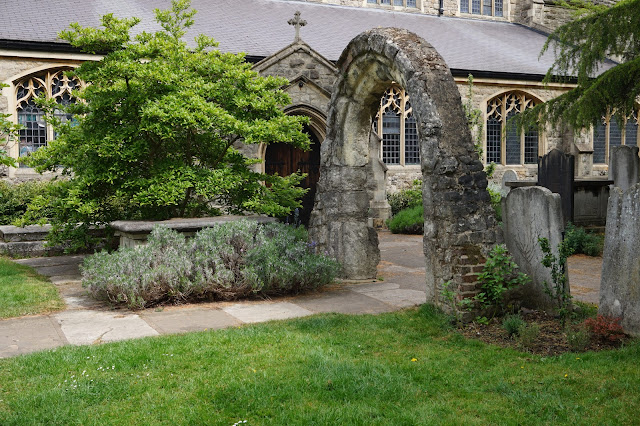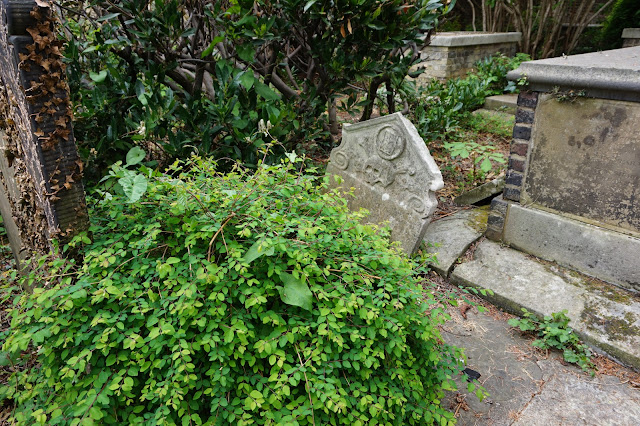This is a rather delayed post, my travels having taken place in May 2022; it is either the fourth or fifth post I've done on mathematician and mage John Dee since 2016 - other posts cover his childhood, his interactions with the Tudor courts, his books, his genealogical scroll, the RCP Dee exhibition, etc. This is the first time I've been able to get out to his home in Mortlake where he lived most of his life, the home in which was housed his huge library (largest in England at the time) and at which he hosted visiting scholars who gained much from interacting with him and having access to his books. Queen Elizabeth I visited him here more than once - quite something to have the monarch show up at one's home, especially when one is not of the nobility! Dee now lies buried in the Church of St. Mary the Virgin, which is right next door to where his home once stood. Though church grounds (and most of the church itself) would not have looked in Dee's time like it does in the pictures here, I find the arch in the churchyard evocative of what I know of Dee. To be casual rather than mathematical or historical here, I found that it reminded me a bit of the archway in Harry Potter and the Order of the Phoenix, which separates the world of the living from the world of the dead. And, so, as I walked through this churchyard archway in the way that I did in the video below I kind of wondered if it was a good idea to be doing so.
John Dee is buried inside the church rather than in the churchyard, but I'll post a few more pictures of the churchyard to give an idea of the place as it is now.
Dee did live adjacent to this church, and when Queen Elizabeth I visited him they conversed while standing by the wall between his property and the church. Where his house once stood there are flats named "John Dee House," but the wall is still there, parts of which seem to be original. In the picture below, look through the trees to see the church tower.
Note again the tower beyond the wall. A tower was here in Dee's time as well, a plaque in the church and plaques on the tower indicate dates relating to the tower (pictured further down), and the tower does seem to have some Tudor architecture but also seems to be a bit of a conglomeration of styles at this point.
The more I travel, the more skeptical I am about stones with dates on them and whether they are original to the structure or if they were placed there later. Above we have the date 1407, which is 120 years before Dee's birth, below is a plaque from 1911 inside the tower stating that the tower was built by Henry VIII in 1542, and the second image below is of a stone in the wall just to the side of the tower which matches the Henry VIII 1542 date, but which I've been told is very likely quite a bit later. Regardless of which parts of the tower are newer or older, there would have been a tower on this site in Dee's time, and some parts from his time may make up parts of the tower we see today.
As I mentioned, Dee is buried within/under the church. It is not known exactly where he lies, both because renovations and reconstructions have happened since his time and because the church is very near the Thames river, so in the more than 400 years that have passed since he was buried, things may have changed underground. There is a plaque inside honoring him.
He was likely buried near the altar.
Dee's property extended down to the Thames and icluded a large garden and an orchard. The view below is across the street and down a path:I didn't leave time for exploring, but I'd like to come back sometime and walk along this path.
Mortlake is quite near Richmond, and Queen Elizabeth I often stayed at Richmond Palace, a palace that was one of her favorites. On the few occasions she visited Dee she came by horseback or by barge down the Thames. Above is the Thames as it would have fronted Dee's property, and below is the Thames as it passes by what was Richmond Palace:
Almost nothing of the palace remains today. There is a gatehouse, and a building known as "The Wardrobe."



































Thank you for the insight. Sadly I can't visit personally.
ReplyDeleteThank you for this informative article and the excellent pictures you shared.
ReplyDeleteYou're welcome - I'm glad you enjoyed it!
ReplyDeleteAs a direct relation of John, Dee, I would like to correct a piece of information, where you suggest, Mortlake, is within Tower Hamlets. Although, he was born in Tower Hamlets, this area, happens to be located in East London, not West London, as you claim. Mortlake, as you know, lies within Royal Richmond-upon-Thames, in West London.
DeleteThank you for reading and for your comment - much appreciated! I've gone back through to look for what to correct, and I'm not finding the reference. Can you please direct me to the paragraph so I can correct any error? (I may have used the term "tower" a bit much. I don't mean that Mortlake is near the Tower of London. What I mean by "tower" is the church tower of St. Mary the Virgin in Mortlake, not the "Tower District" in London where he was born - though some biographers give Greenwich as a possible birthplace, based on his "nativity." Might my repetitive use of the word "tower" - in reference to the church - be the issue?)
DeleteBrilliantly conversational and detailed. Thank you.
ReplyDeleteI'm so sorry to have missed this comment when it came in. I really appreciate you reading and taking time to leave such a kind comment. Thanks!
ReplyDelete